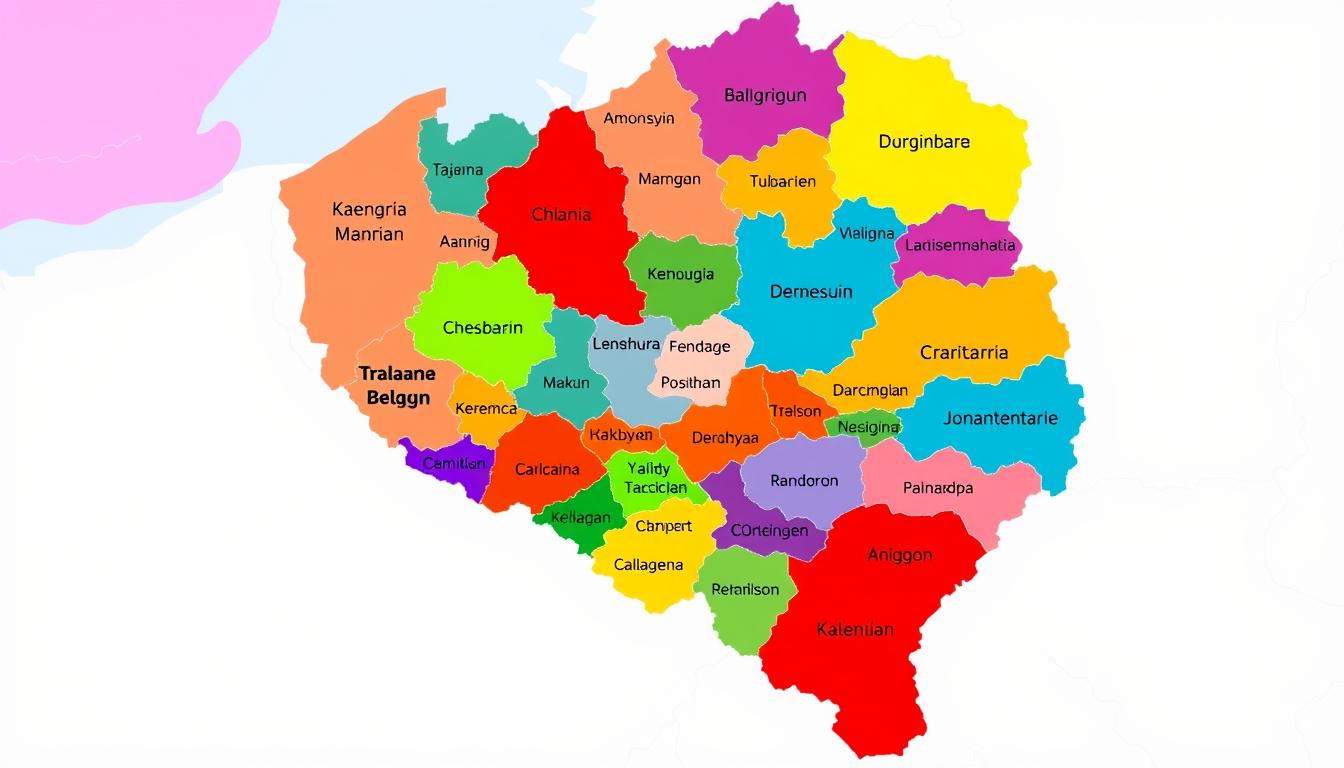Belgium sits at the heart of Europe, blending cultures from Germanic and Romance-speaking areas. Ever wondered about the country’s official languages and their roles in its society? Let’s explore the unique linguistic mix that makes Belgium stand out in Europe.
Key Takeaways
- Belgium has three official languages: Dutch (Flemish), French, and German.
- Dutch is the most widely spoken primary language, used by around 59% of the population.
- French is the second-most prevalent language, used natively by approximately 40% of Belgians.
- German is the least spoken official language, with less than 1% of the population using it as their primary language.
- Belgium’s linguistic diversity is a result of its strategic location and historical influences.
Introduction to the Linguistic Diversity of Belgium
Belgium sits between the Germanic and Romance-speaking areas of Europe. This spot has shaped its language mix. The country’s history, with many foreign rulers, adds to its language variety. The three main languages – Dutch, French, and German – show this history and location.
Belgium's Strategic Location and Historical Influences
Belgium is at the heart of Western Europe, blending languages and cultures. Its spot between Germanic and Romance-speaking areas created a special language mix. Over time, it was ruled by Spain, Austria, France, and the Netherlands. Each ruler left their language and identity mark.
Overview of the Three Official Languages
Belgium has three main languages – Dutch, French, and German. Dutch is mostly spoken in the north, in Flanders. French is used in the south, in Wallonia. German is spoken in a small eastern area, the German-speaking Community of Belgium.
This mix of languages is made richer by local dialects and minority languages. English is also common, especially in Brussels.
“Belgium is a country where the languages of two great European civilizations – Romance and Germanic – meet and mingle.” – Historian
Knowing about Belgium’s language diversity helps us understand its culture and navigate its multilingual society.
Dutch: The Most Widely Spoken Language in Belgium
Dutch, also known as Flemish, is the main language in Belgium, spoken by about 59% of people. It’s similar to Dutch spoken in the Netherlands but has its own differences in words, pronunciation, and sayings. Flemish Dutch is the official language in the Flemish Community and Region, mainly spoken in the northern part of Belgium.
Flemish Dutch vs. Standard Dutch
Flemish Dutch in Belgium is different from the Dutch in the Netherlands. It has its own special words and expressions. The way it’s pronounced also sets it apart, with a unique accent and way of speaking. It also has grammar rules that are not the same as standard Dutch.
Even with these differences, Flemish Dutch and standard Dutch are easy for each other’s speakers to understand. Flemish Dutch is mainly used in the Flemish-speaking north of Belgium. Standard Dutch is more common in the Netherlands.
Geographic Distribution and Demographics
In northern Belgium, Dutch is the main language, spoken by three-fifths of the people. It has its own special words and grammar, unlike standard Dutch. The everyday form of Dutch in Belgium, called Tussentaal, uses words and sounds from Brabantic dialects. It’s a mix of Dutch.
Statistics show that Dutch is the first language for about 60% of Belgians, which is around 6.5 million people out of 11 million. In Brussels, only 5.2% of people in a 2013 survey spoke Dutch at home. Most people there spoke French.
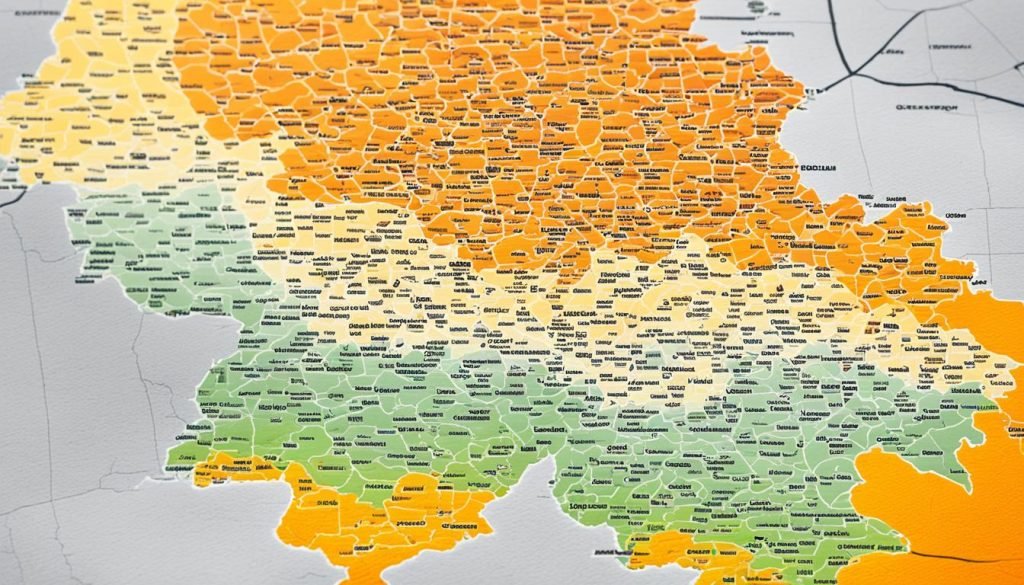
“Dutch has been gaining importance in Wallonia, particularly in tourism, with more Dutch-speaking staff in enterprises catering to Flemish and Dutch visitors in the Ardennes region.”
Over the last 50 years, Dutch has become more important in Belgium. This change shows a move away from French as the main language. Dutch is now more used in areas like tourism, where staff speak Dutch to welcome Flemish and Dutch tourists.
French: The Second Most Prevalent Language
In Belgium, French is the second most spoken language, used by about 40% of people. Belgian French is very similar to French spoken in France but has its own unique words, ways of speaking, and meanings. Knowing these differences is key to getting along in Belgium’s diverse language scene.
Belgian French vs. Standard French
Belgian French and standard French share a common base but have many differences. These differences show up in several areas:
- Vocabulary: Belgian French uses special words and sayings that show the country’s unique culture and history.
- Pronunciation: Belgian French speakers often speak with a more nasal and guttural sound than those in France. They also use different vowel sounds and rhythms.
- Semantics: Some words and phrases in Belgian French mean different things than in standard French. You need to pay attention to how they are used in context.
These differences can sometimes cause confusion, especially for those used to French from France. Learning about Belgian French is important for anyone wanting to talk and connect with people in Belgium.
“Understanding the unique characteristics of Belgian French is essential for effective communication in the country’s diverse linguistic landscape.”
French is an official language in the French Community and the main language in southern Wallonia, Belgium. Its widespread use and the special traits of Belgian French make it a big part of Belgium’s rich language mix.
German: The Minority Language with Official Status
In Belgium, the German language is an official language, even though Dutch and French are more common. It’s spoken by about 77,000 people in the eastern part of the country near Germany. This group forms a small but vibrant minority.
The German-Speaking Community of Belgium
The German spoken here is very similar to the standard German in Germany. This shows the strong cultural and historical links between the German-speaking Belgians and their neighbors. But, the use of French and German among the young is changing, with French becoming more popular.
Since the 1980s, the German-speaking community has had more power and control over their language and culture. In 1984, a special council and government were set up to look after these matters. This ensures the German language and culture are kept alive and valued.
In schools, German is the main language, and French is taught as a second language. Knowing German is important for jobs, especially in the public sector. The community also supports the arts and education, showing how important the German language and culture are.
As of 2019, there were 77,527 people in the German-speaking community, making up just 0.7% of Belgium’s population. The area they live in covers 846.1 km², which is 2.8% of Belgium and 5% of the Walloon Region. Despite being small, the German-speaking community is a key part of Belgium’s rich mix of languages.
| Statistic | Value |
|---|---|
| Population of the German-speaking Community (2019) | 77,527 |
| Percentage of Total Belgian Population (2019) | 0.7% |
| Area of the German-speaking Community | 846.1 km² |
| Percentage of Belgium’s Total Area | 2.8% |
| Percentage of Walloon Region’s Area | 5% |
| Population Density | 91 inhabitants per km² |
| Percentage of Foreigners in the Population (2019) | 21.1% |
| Average Age of the Population (2019) | 42.7 years |
| Gross Value Added in Manufacturing (2017) | 21.7% |
| Employees Subject to Social Insurance (2017) | 22,685 |
| Gross Value Added per Employee (2017) | 77,181 euros |
The German language is very important in Belgium, thanks to its history and culture. The German-speaking community works hard to keep their language and traditions alive. This shows Belgium’s support for many languages and cultures.
Belgium: Official and Widely Spoken Languages
Belgium is known for its diverse languages, with three official ones: Dutch, French, and German. This comes from its spot between Germanic and Romance Europe, and its history with different rulers.
About 59% of people speak Dutch, also known as Flemish, in Belgium. French is spoken by around 40% of the population. Less than 1% speak German, mainly in the eastern part of the country.
In the Flemish area, there are many dialects like Brabantian and West Flemish. Wallonia has its own dialects, including Walloon and Picard.
Most Belgians can speak several languages, showing the country’s multilingual nature. Flemish people often know Dutch, French, and English or German. French-speaking people in Wallonia speak French and Dutch. Germans in Belgium speak German, French, and Dutch.
Brussels, the capital, is officially bilingual. People there speak both French and Dutch, with French used more often.
| Language | Percentage of Population |
|---|---|
| Dutch | 60% |
| French | 40% |
| German | 1% |
Belgium’s mix of languages and dialects shows its unique culture and diversity. It makes the country interesting to visit.
Language Legislation and Policies in Belgium
Belgium has a long history of laws and policies about languages. These have shaped how Dutch, French, and German are used in public places. Over time, the rules have changed to keep the country’s language mix.
Legal Framework for Language Use
The Belgian Constitution lets people choose their language in private life. But, there are rules for public use and legal matters. Important laws have been passed to manage language use:
- In 1873, a law about language use was passed, influenced by public opinion, like the case of Jozef Schoep who refused to use French for his son’s birth.
- The 1898 Law on Equality made Dutch and French equal official languages, thanks to public support.
- Since 1921, the law has said which language is used in each region of Belgium, confirmed in 1932 and 1962.
- The 1970 change to the Constitution made it hard to change a town’s language without a special law.
Language in Education and Government
In Belgium, language rules are key in schools and government. After the 1873 law, Dutch became the main language in Flanders, but French is still used in some cases. The Administrative Language Act sets rules for language in cities, towns, and government departments.
In schools, classes are taught in the official language of each area. The National Railway Company of Belgium gives train information in the local language. Road signs also show places in the local language, making it important for travelers to know several languages.
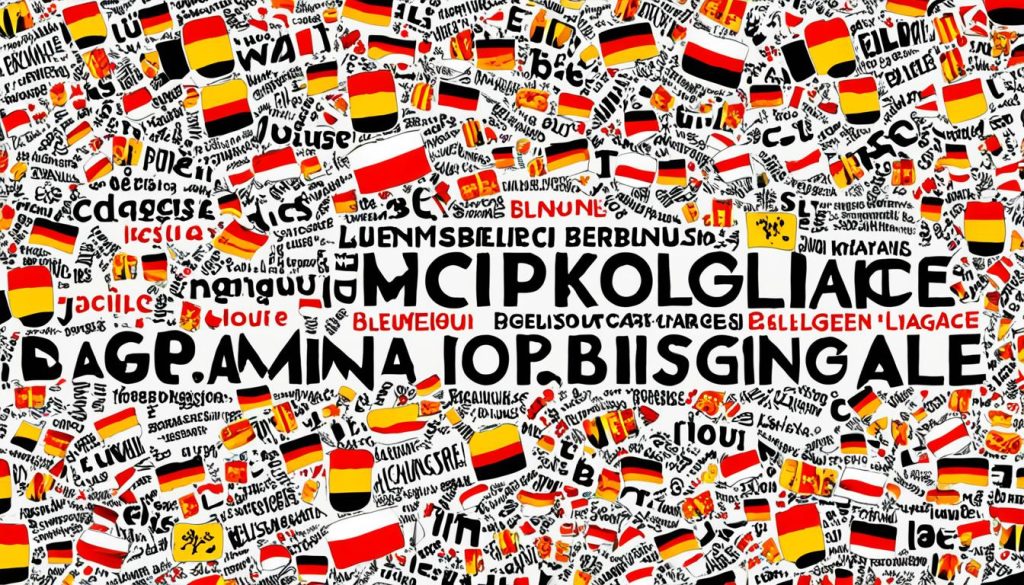
Belgium values its diverse languages and culture. It scores high in multicultural policies, giving autonomy to regions, and supporting minority languages in education and media. This makes Belgium a place where knowing many languages is common.
Multilingualism: A Hallmark of Belgian Society
In Belgium, many people speak more than one language. About 38% use a second or third language at work, and 27% can talk in three or more languages. This shows how important multilingualism is in Belgium. It comes from the country’s linguistic diversity and focus on language skills.
Belgium has two main official languages: Dutch and French. The capital, Brussels, is bilingual, making up about 10% of the population. Flanders and Wallonia each have their own official language: Dutch in Flanders and French in Wallonia.
But Belgium’s language scene is more complex. Recent stats show:
- About 60% of Belgians, or 6.5 million people, speak Dutch.
- Around 40% speak French, making it the second most common language.
- About 1% speak German, which is the least common official language.
- 18,000 Orthodox Jews in Antwerp speak Yiddish.
- 10,000 Romani people speak Sinte Romani in Belgium.
This variety of languages shows Belgium’s rich culture and its effort to keep multilingualism alive.
Proficiency in Multiple Languages
Belgians are good at speaking many languages for several reasons. The country’s location, history, and education policies help. These factors have made language skills common among the people.
In some French schools in Brussels, up to 50% of students don’t speak French at home. In Antwerp, 44% of primary school kids and 31% of secondary school students didn’t speak Dutch at home in 2013-2014. This shows how important multilingualism is in schools.
“One third of 800 teachers in nearly 50 Flemish secondary schools approve of punishing pupils if they speak languages other than Dutch.”
Even though multilingualism is valued, some schools struggle with it. Many teachers in Flemish schools think punishing students for speaking other languages is right. This can stop students from improving their language skills and celebrating multilingualism.
Belgium’s push for multilingualism shows its rich culture and effort to be inclusive. The high proficiency in multiple languages among its people is a sign of this.
Regional Languages and Dialects
Belgium has three main languages: Dutch, French, and German. But there’s more to the country’s language scene. It’s full of regional languages and dialects that show its rich history and culture.
Romance Languages: Walloon, Picard, Champenois
Walloon, Picard, and Champenois are Romance languages spoken in Wallonia, the French-speaking part of Belgium. Walloon is a French dialect with its own special words, grammar, and sounds. These languages are important to their communities, even if they’re not officially recognized.
Germanic Dialects: West Flemish, Limburgish, Brabantian
In the Dutch-speaking north of Belgium, you’ll find Germanic dialects like West Flemish, Limburgish, and Brabantian. They’re similar to Dutch but have their own unique traits. These dialects are loved by their speakers and add to the region’s linguistic diversity.
These regional languages and dialects show Belgium’s long history of cultural and linguistic diversity. They may not be as widely recognized as the main languages, but they’re key to the Belgian identity. They keep the local traditions and identities alive.
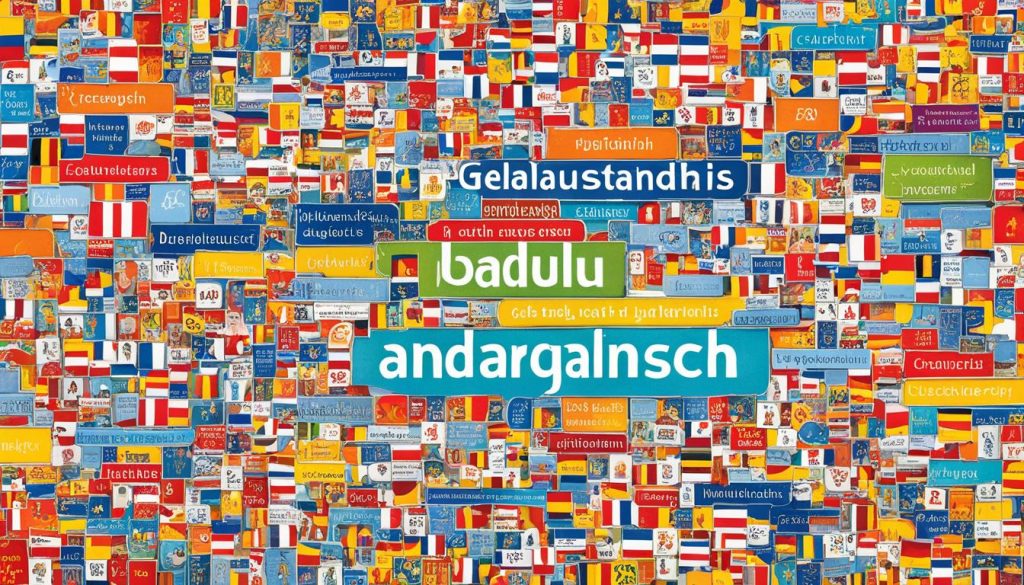
“The linguistic diversity of Belgium is a reflection of the country’s complex history and cultural influences. These regional languages and dialects are a vital part of the nation’s heritage, preserving the unique identities and traditions of their respective communities.”
Language Dynamics in Brussels
Brussels, the capital of Belgium, has a complex language scene. It’s officially bilingual in Dutch and French but mostly speaks French. Only a few people speak both languages well. This mix comes from people moving in and out of the city over time.
Bilingualism in Theory and Practice
Brussels says it’s bilingual, with Dutch and French as official languages. But in real life, it’s more French. About 10% of people speak Dutch, and many others are from other countries. This mix makes for a unique language scene, with French being the top choice for daily talk.
English as a Lingua Franca
English is getting more popular in Belgium, but not as much in Brussels. Almost half the people in Brussels speak English well. Yet, you might still need French or Dutch for everyday conversations. This shows English isn’t as widespread as you might think in a big European city.
Brussels shows how hard it is to manage many languages and official policies. As the city grows, finding a way to keep everyone together will be key. It’s important to honor the city’s diverse languages and cultures.
| Statistic | Value |
|---|---|
| Non-Belgian population in Brussels | 36.9% |
| EU citizens in Brussels | Around 25% |
| Fluent English speakers in Brussels | Nearly 50% |
| Increase in Dutch speakers in Brussels (2018-2022) | From 16% to 22.5% |
| Non-Dutch, French, or English speakers in Brussels | Increasing in the past 25 years |
Linguistic Tensions and Challenges
Belgium’s mix of languages has caused ongoing political and social issues. The language divide between the Dutch-speaking Flemish and the French-speaking Walloons has led to big challenges. These have caused political fights and disagreements on policies. This has deeply affected how Belgium is run, its schools, and how people live together.
One big issue is how languages are treated and represented. Flanders is mostly Dutch-speaking, while Wallonia is mostly French-speaking. This difference has caused feelings of unfairness about how resources are shared and decisions are made. This has made both sides upset.
Disagreements also come from how languages are used in government, schools, and public services. For example, civil servants needing to know both Dutch and French has caused arguments. Flemish politicians want more policies focused on Flemish.
| Language Community | Percentage of Population |
|---|---|
| Dutch-speaking Flemish | 55% |
| French-speaking Walloons | 36% |
| German-speaking Community | Less than 2% |
These language issues have also affected Belgium’s political stability. Problems over language have led to government crises, like the 1983 Voeren incident and the 2008 Linkebeek dispute. These events show how delicate the balance is and the need for ways to solve conflicts.
But, there are also positive steps being taken. There’s a push for everyone to know more languages, including both Dutch and French. Also, English is becoming a common language for talking and working together. This could lessen the effects of the language divide.
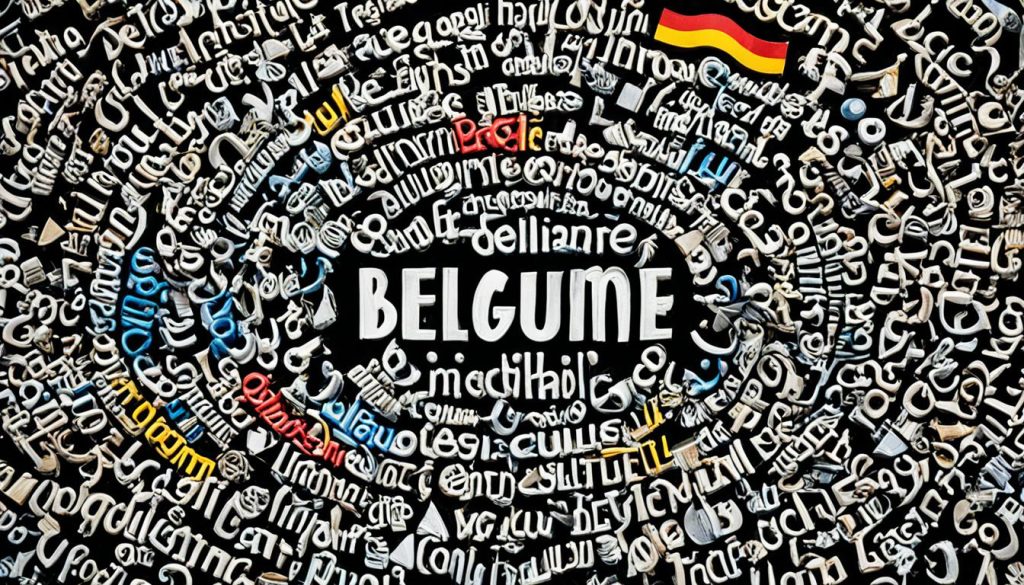
Belgium is working through its language issues. It’s important to tackle the challenges from the language divide to keep society and politics stable. Encouraging talking between people, supporting bilingual education, and creating inclusive language policies can help. This could make Belgium more united and prosperous.
Conclusion
Belgium’s language scene is fascinating and complex. It has three official languages – Dutch, French, and German. There are also many regional languages and dialects. This shows how Belgium’s geography and history have shaped its language diversity.
This diversity has led to some language tensions. Yet, it also makes Belgian culture richer and the country a key place for speaking many languages in Europe.
Exploring Belgium’s languages reveals a rich mix that defines the nation. Dutch is most common in the north, while French is in the south. German is spoken by a small but important group.
But there’s more to Belgium’s languages. There are regional tongues like Walloon, Picard, and Champenois. Yiddish is also important in the Jewish community. This variety of languages shows Belgium’s deep cultural roots and its people’s ability to speak many languages.
